Mark Sisson's Blog, page 201
December 2, 2016
This Lifestyle Taught Me That Life Can Be So Much Better!
It’s Friday, everyone! And that means another Primal Blueprint Real Life Story from a Mark’s Daily Apple reader. If you have your own success story and would like to share it with me and the Mark’s Daily Apple community please contact me here. In fact, I have a contest going right now. So if you have a story to share, no matter how big or how small, you’ll be in the running to win a big prize. Read more here.
 Ever since I could remember, I’ve been plagued with bloating, constipation and brain fog. I’d grown accustomed to it and accepted it as something my mother passed down to me. When I was four, my family and I emigrated from Poland to the U.S. I vividly remember eating healthy dinners that my mom cooked, but also loads of sugary cereal, Pop-Tarts, Snickers, sandwiches, cakes, Coke, Sprite, etc. I was chubby as a kid, and would remain so for many years.
Ever since I could remember, I’ve been plagued with bloating, constipation and brain fog. I’d grown accustomed to it and accepted it as something my mother passed down to me. When I was four, my family and I emigrated from Poland to the U.S. I vividly remember eating healthy dinners that my mom cooked, but also loads of sugary cereal, Pop-Tarts, Snickers, sandwiches, cakes, Coke, Sprite, etc. I was chubby as a kid, and would remain so for many years.
When I was eleven we moved back to Poland. Six years later I visited Sweden and saw that many people there were proper vegetarians. In my home country this was virtually impossible – at most you could be a pescetarian, but even then you were regarded as a freak. I decided to become one – a pescetarian, that is, to satisfy my parents – partly a rebellious act but mostly because I did not like the texture of meat.
Gone was the meat from my diet, but what to eat instead? Vegetables were a no-brainer, I was always a big fan, but because I refused to learn to cook, I started seeking out vegetarian foods at supermarkets. The vegetarian market was slowly expanding, so why wouldn’t I try out the latest tofu, soya and rice burgers/sausages/etc? They were all heavily processed and tasted bland, if not disgusting.
My mother bought me several vegetarian cookbooks but they were too difficult to follow for someone who didn’t know the basics. To this day I do not like cookbooks which don’t have pictures to go with the recipes. I quickly got discouraged and existed mostly on what I called the Brad Pitt diet – coffee, sandwiches and beer (the latter two were what allegedly fueled him when he was just starting out in the business). I had always been on the slightly puffy side, but at university I was borderline overweight – at 168cm/5ft6 I weighed 69 kg/152 lbs.
As for exercise, I tried a few classes and clubs when I was a kid but no sport ever stuck. In high school most of the girls in my class were clumsy and unathletic, which made me seem very sporty, although I wasn’t really (which is something my gym teacher pointed out).
Towards the end of of high school I signed up for kung fu class, which I would practice for a year and a half. I enjoyed it a lot but pain in my knees forced me to quit. At physical therapy I was told I would have bad knees for the rest of my life.
I stopped exercising and tried to focus on my schoolwork. I wasn’t very good at academics, consistently at the bottom of my class all throughout high school. I could not focus on subjects I did not enjoy and failed one of my exams at the end of high school. Years later I realized it could have been because I was always told as a kid that I am ‘smart’ and ‘talented,’ which made me subconsciously think I did not have to put in the work to achieve academic success. If it didn’t come easily to me, I would almost definitely fail. Now I think that in addition to this, brain fog and inability to concentrate also played a factor.
At one point, it was probably in the first couple of years at university, I went to a masseur complaining of backache. I thought it was due to years of slouching, brought on by early onset puberty and the embarrassment of growing breasts that started when I was 11. My back muscles were so tense the masseur could hardly touch them without me yelping in pain. He said I had the body tension of a 45-year-old and I should start exercising. I took the advice to heart and signed up to an aerobics class. Yes, it was chronic cardio, but I loved pounding it out for an hour on the step to loud music. I realized exercise could be fun and did not need complete commitment (as kung fu did).
After five years of studying international relations, I was physically at a low. I enjoyed the studies (and thus had an easier time academically), but constant drinking, smoking and eating vegetarian crap was taking a toll. I would get to work hungover, after work go to my evening classes, then stay up drinking with my buddies, get home late, eat more crap, sometimes drink more, have bad quality sleep and struggle in the morning. I cheated myself into thinking that I was ‘healthy’ because I didn’t eat meat, I didn’t smoke that much, some of my (male) friends drank way more than I did and, hey, I ate salad for lunch everyday!
The worst thing was not the weight creeping up on me, but the PMS symptoms. I had been on the pill since I was probably thirteen to control the symptoms, flow and timing (I wouldn’t want to get my period while on vacation, now would I?), but PMS had become unbearable. For two weeks before my period I had excruciating underbelly pain that could only be alleviated with super warmth – either hot drinks or hot compresses to the stomach. At home I used a heat pad, which wasn’t hot enough, but at work I would use.. an electric kettle that had just boiled water. I had burn marks on my stomach from pressing the kettle through my clothes into it, but it had the best effect. I drank so much hot tea and coffee that towards the end of the working day I just drank plain hot water, sometimes with a squeeze of lemon. Painkillers would work for maybe 30 minutes, so I didn’t bother to use them.
Another symptom was constant eating. I could not satisfy my hunger before my period. After a hiatus I started going to a nearby aerobics class not for the benefit of exercising, losing weight or getting in shape, but just to pry myself away from the refrigerator.
I started to educate myself on healthy eating, but I still thought vegetarianism and potentially veganism were the only healthy way. Several years down the line, when I had moved to London, started a new job and met my partner, my weight ballooned to over 90 kg/198 lbs when I was pregnant with twins. The weight gain was normal and healthy but my sluggishness, breathlessness and size towards the end of pregnancy made me think, how can obese people live like this? I made a vow to really take care of myself.
 A few months after the birth of my twins I bought some exercise DVDs. My pregnancy weight started to fall off. I finally started to learn to cook because I knew that a healthy diet was important, especially for my babies. This photo was taken 8 months after my twins were born.
A few months after the birth of my twins I bought some exercise DVDs. My pregnancy weight started to fall off. I finally started to learn to cook because I knew that a healthy diet was important, especially for my babies. This photo was taken 8 months after my twins were born.
In January 2014, a friend convinced me to start training for a 10k fun run. I had never liked running but decided to give it a shot. I ran, or rather jogged, the race in May, but at what cost. I had been plagued by leg and glute injuries, I felt fatigued a lot of the time. I ate too much and too often. I wanted to do 24-hour fasts once a week but could not sustain them. I was irritable, craved sugar, salt and alcohol in the evenings and generally felt annoyed with myself.
So after the race, I had a couple days rest, then resumed running, cycling and strength training – until exactly a week later, on a overcast, drizzly Sunday, my body just refused to do what I was telling it to do. I walked the route I wanted to run. My thigh and glute injury was acting up. My ankles, left shoulder, left side of my neck, all hurt. I had side stitches. I realized that I’d felt this tired after my very first run about 5 months ago.
For the next couple of days I gave my aching joints and injuries a break. Even my arms hurt – biceps, forearms, and wrists – which I attributed to a first-time kettlebell workout from a few days ago (assuming delayed soreness).
I did some research and came to the conclusion I need to take a closer look at what, how and when I ate and drank. I have Hashimoto’s and realized that I might be more susceptible to gluten sensitivity and rheumatoid arthritis. I bought a cookbook, ‘It’s All Good’ by Gwyneth Paltrow and Julia Turshen. Think what you want about Gwyneth, but her book opened my eyes to elimination diets, gluten-free eating that could be delicious, and the importance of taking care of my body through food.
At some point I came across a website – I honestly don’t remember if it was Mark’s Daily Apple or not – which shunned not only grains, but even whole grains! That’s insane, I remember thinking, grains are the base of the food pyramid! Meat as part of a healthy diet? Impossible. I spent hours researching these topics and even came across stories of people who ate only meat, and sometimes specific types of meat, and claimed to be super healthy and fit. I had many conversations with my brother-in-law, who is an osteopath and an advocate of SCD and WAPF, and whose stint with veganism a while back landed him in the hospital.
I knew now for sure that I had to change my diet. I was suffering with injuries, stiffness, aches, brain fog, constipation, gassiness, bad PMS, low libido, hypoglycemia, bloat, coldness of extremities. I was eating every two hours. My weight loss had plateaued. But one of the worse things was what I started calling gluten-rage. I would get so angry with my kids over the silliest reasons, and I hated myself for it.
In September 2014, I started eating meat again after 15 years. By October, I had stopped eating grains. However, I became obsessed with food. I would cheat and hate myself for it. I would swear I would not eat sugar/peanut butter/drink alcohol, and I would constantly think about what I was missing out on, and usually after a few days, maybe a week, I would binge on whatever I had been denying myself.
I got tested for coeliac disease [negative] and food sensitivities [so many!]. I drove myself crazy eliminating everything I was ‘sensitive’ to. I had to stop thinking of food as a reward or punishment and focus on healing my gut.
 Aerosmith sang ‘Life’s a journey, not a destination’ and this is always something I keep in mind. I practice listening to my body, to what it needs. I follow Paleo/Primal principles, but do not obsess about my eating habits anymore. I don’t care what the scale says or what I’m supposedly sensitive to – how I feel is what matters. I have eliminated many ailments and that makes me so happy. I still have a few issues which I suspect are related to Hashimoto’s, that’s why I am currently reading ‘The Paleo Thyroid Solution’ by Elle Russ. The Paleo lifestyle has taught me that life can be so much better, and to never give up on improving yourself.
Aerosmith sang ‘Life’s a journey, not a destination’ and this is always something I keep in mind. I practice listening to my body, to what it needs. I follow Paleo/Primal principles, but do not obsess about my eating habits anymore. I don’t care what the scale says or what I’m supposedly sensitive to – how I feel is what matters. I have eliminated many ailments and that makes me so happy. I still have a few issues which I suspect are related to Hashimoto’s, that’s why I am currently reading ‘The Paleo Thyroid Solution’ by Elle Russ. The Paleo lifestyle has taught me that life can be so much better, and to never give up on improving yourself.
My partner and kids are not Paleo, but I like to think my principles and cooking have a good influence on them. My six-year-old kids are very good eaters, have superb immune systems, have always slept so well and are good-natured and well-behaved (mostly) compared to so many other kids I know. I believe the food we eat have a massive influence on our wellbeing.
The post This Lifestyle Taught Me That Life Can Be So Much Better! appeared first on Mark's Daily Apple.



December 1, 2016
17 Gifts That Will MOVE You
 Today’s guest post is by Katy Bowman, biomechanist and author of the bestselling Move Your DNA and a new release, Movement Matters, which examines our sedentary culture, our personal relationship to movement, and some of the global effects of outsourcing movement. I’m happy to welcome her back to Mark’s Daily Apple.
Today’s guest post is by Katy Bowman, biomechanist and author of the bestselling Move Your DNA and a new release, Movement Matters, which examines our sedentary culture, our personal relationship to movement, and some of the global effects of outsourcing movement. I’m happy to welcome her back to Mark’s Daily Apple.
Ancestral health models have begun reaching beyond diet and have expanded to include sleep, stress, parenting practices, and movement. This leads to the question, “Can we better incorporate the ideas of ‘natural health’ into our holidays?”
Of course we can! We can prepare our holiday meals with better-sourced ingredients and eliminate the things we know aren’t doing our bodies good. But beyond the primary meal, are there other aspects of a holiday we can consider? Spoiler alert: there are.
I’ve always loved giving gifts. Choosing the right book, the perfect necklace, the coziest sweater for someone I love has always been an essential part of the holidays for me. But in recent years, I’ve run into a gift-giving dilemma. Most people I know complain about having too much stuff, and many are striving for a more minimal approach to life, from footwear to furniture.
Many are trying to find ways to add more movement to their lives beyond exercise—and to stop outsourcing so much of their movement to items of convenience produced with the expense of fossil fuel production, in some other area of the globe, in conditions we wouldn’t find acceptable were we the ones having to labor.
The more I’ve come to understand the ecology of human movement—how directly exchanging our own personal movement for the things we require in our daily life not only improves our personal physiology, but can decrease the strain we place on other humans and the planet—the fewer irresponsibly manufactured items I feel comfortable gifting.
BUT I LIKE TO GIVE PRESENTS! So, how can we be generous and festive, revel in the joy of giving, while reclaiming our outsourced movement and addressing our essential human need to MOVE? How can we be generous with our family and friends and our communities and our own bodies and the rest of the world all at the same time? Is it even possible?
It is. Behold, for I bring you great tidings of joy: a list of holiday gifts that not only get you and your giftee moving more, but also increase what I call “vitamin Nature” and “vitamin Community”—other important aspects of ancestral health.
If you’re feeling pressed for time, don’t fret (fretting doesn’t need to be part of a celebration); there is all sorts of gear you can quickly source that encourages more movement, more natural movement, and more nature—i.e., it will get someone moving after the gift has been given.
GIFTS TO BUY…
These are a step up from the conventional store-bought gift in terms of their impact on your giftee’s body and life.
Squat Platforms
Here, I’ll just say it: Everybody poops. If you want more movement in your life (and in your bathroom), use a squat platform to toilet. More squats and less bearing down. If you want to get moving more, too, download DIY instructions and build one to gift, or gift a Squatty Potty (I’m going out on a limb and suggesting this gift is best given to someone you know pretty well). They’re made in the USA, i.e., with labor practices you can stand (or squat) by.

Hiking Guidebooks
A hiking guidebook is like an invitation to move through nature, not only for exercise but to de-stress and connect with the bigger picture. There are all sorts of hiking books—some for families, and some for those with creaky knees. Bonus points if you take a walk down to your local bookstore to find guides local to your area, by local experts. Even regular exercisers on your list can be unaware of all the beautiful trails within their reach.
Foraging Guidebooks or Wild Food Cookbooks
An excellent companion to #2, a good foraging guidebook can introduce your loved ones to the landscape around them. Moving directly for our food allows for a far wider range of movements than we usually get—squatting to collect berries, reaching for fruits, digging for tubers—and it results in nutrient-dense food!
Wild food is completely unprocessed, meaning some part of you—teeth, hands, arms—needs to work to get it ready to digest. Foraging and wild-food cookbooks are typically applicable to certain geographical areas. Research carefully as the region covered by the book should be noted. Again, search out local foragers, and connect with them online or in person (vitamin Community!) as they’re likely well-versed on the best books for their areas.

Hiking and Foraging Accouterments
Moving through nature is our family pastime, so often the gifts we give are things that allow us to stay outside longer. A thermos full of a hot drink makes a winter hike much more appealing. Fill one with hot ginger tea or bone broth, and you’re ready to keep warm on winter hikes. And a foraging bag or basket for foragers big and small makes it easy to keep moving as you collect.

Human-Powered Kitchen Tools
There used to be, and can still be, a ton of movement going into your meals. A hand coffee grinder, mortar and pestle, potato masher, and traditional food mill that you can use instead of a stick blender to purée soups all offer your giftee the opportunity to move more in the kitchen and save electricity in the process (and speaking of electricity, if you’ve got a giftee looking to understand more about how electricity makes it into one’s home, check out The Grid: The Fraying Wires Between Americans and Our Energy Future).
Bonus: doing things by hand also means fresher ingredients—there’s nothing like the scent of fresh herbs and spices being pulverized by the mortar and pestle.

A Living Tree
For those whose holidays include a Christmas tree, give the gift of a living tree in pot. You can buy traditional potted Christmas trees and then plant them after the holidays are over (an amazingly movement-filled activity), or you can go for an unconventional tree—like a fruit tree—which will continue to offer gifts far into the future.
Bushcraft Experience
There are experts in many communities willing and excited to pass on their knowledge of wilderness survival. Buy a gift certificate for a traditional firebuilding class, a class on how to build a shelter, or how to track animals. These skills aren’t quaint throwbacks—having them not only affords us a huge range of movements never called on in the modern Western world, but also makes nature and wilderness a more appealing place for us, so we’ll spend more time moving in nature, which will make us even better at those skills, which will make nature an even more appealing place for us to be, so we’ll spend more time in it… You get it, right?
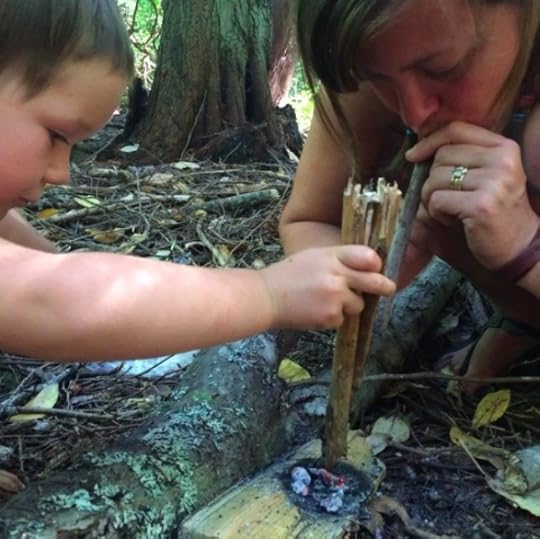
A Plot in a Community Garden
Do you know someone who’s been dying to start growing more of their own food but doesn’t have the space? Many cities have community gardens established where plots can be purchased or rented.

GIFTS TO CREATE…
Handmade gifts typically require greater exchange of your personal time and movement—something that can make them even more treasured.
Functional “Crafts”
Perhaps thanks to Pinterest, it seems we’re going through a second Arts & Crafts period. Before you start groaning here, let me say I am HORRIBLE at arts and crafts. However, a few years ago my family decided to gift only handmade items, and it turned out homemade doesn’t equal crafting at all. It just equals labor (read: movement). Movement, I am good at, especially when it comes to turning wild food (like elderberries) into something functional (like medicinal elderberry syrup).

You’re probably already good at something, like knitting or sewing, or woodworking, or painting, or people walking (seriously). Put your skills to work to make your gifts this year (how about sewing reusable grocery bags or building small raised beds that support future movement?). You can also consider learning a new skill before the holidays—learn to crochet a simple scarf or hand-build a mug. Each skill you learn brings you more opportunity for movement, making every gift something you’re also gifting yourself!
Wild-Harvested Food Gifts
If you have any foraging or hunting knowledge, use it (and thus your movement) to create a delicious food gift. Some of my most favorite gifts include a bag of wild rice, a jar of dehydrated rosehips, and a bag of venison steaks. Another way of moving comes after the wild ingredients are sourced: make acorn-flour cookies, roast fresh chestnuts, make cranberry sauce from foraged berries, turn porcini mushrooms into a savory shortbread, or fill your giftee’s freezer with a moose lasagna. P.S. I’ve had moose lasagna, and it’s delicious.
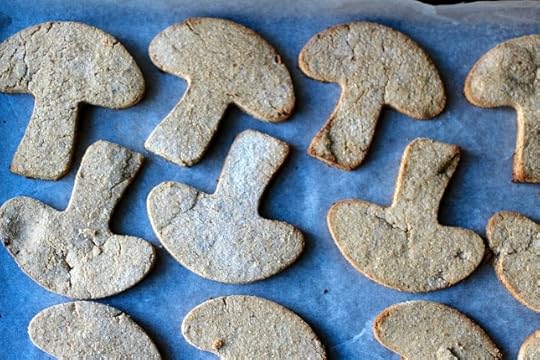
Local/Sustainable Food, Prepared by You
If you’re a homesteader, you’ve probably done this for years. For those of us just catching up, walk to (or through) the farmer’s market or head to a U-pick farm and gather ingredients to make jams, jerky, pies, pemmican, and more.

A Handmade Wreath or Winter Flower Bouquet
Harvest boughs from living trees yourself, collect acorns and pinecones and holly berries, and give someone a beautiful, fresh, movement-made wreath. Or take a walk to harvest branches, grasses, and winter blooms and make your giftee a beautiful nature arrangement that will last the entire winter.
Potted Herbs
If you have a green thumb, toss the rest of us a bone. Transplanting a little pot of basil or creating a more complex indoor gardening system (a living wall, yay!) is not only a gift of fresh future food, it’s also a gift of movement: to tend to the plants, to harvest their leaves, and to process the herbs into something they might just invite you over to eat (win-win!).

As I’ve already said, many in our culture have so much and know it. This year, like no other before, I’ve been hearing more and more loudly from friends and family, variations of “I really don’t want any more stuff.” Thus, I’ve started thinking about how to apply the “move more” mentality to gifting experiences that benefit those beyond my normal gift-giving circles.
Serve Others Directly
While this idea isn’t new, it is sadly underutilized. So consider this a reminder: You can check in with your local soup kitchen to see what’s needed this season (and beyond). You can start working with others to gather unused foods from local trees and farms and delivering them to food banks. You can also work directly in the kitchen—use your body to chop, stir, ladle, and carve to feed those far less fortunate and privileged. If you celebrate Christmas, this can be an incredibly rewarding, invigorating way to spend time during the holidays. (And again, beyond—your volunteering journey can begin during the holidays, but continue during the rest of the year.)
Build a “Little Free Library”
Organize a group of people you normally exchange gifts with to make a Little Free Library together for your community. Walk to a secondhand bookstore to fill the shelves, or request each gift-giver donate books from their own shelves. Little Free Libraries aren’t only about the books; they make your neighborhood more inviting to walkers. Not only will you be moving together to build and stock it, you’ll be encouraging your community to move (and learn) more too.

Volunteer at or Create a Community Garden
If there is a community garden already in operation in your neighborhood, ask your friends to donate their time and movement with yours and assist in putting gardens to bed for the winter (or, if you’re down under, to tend and grow!).
And guess what: If there isn’t a community garden in your neighborhood, you can make one. Do the work of talking to your local government about permission, secure some land (many churches and schools are happy to donate space to this endeavor), and get some materials donated from a hardware store. Then you and your fellow gift-givers can set up a community garden to be planted in the spring. The movement involved in tending to food is another gift that keeps on giving.
Go Caroling on Behalf of Your Local Food Bank
Choose traditional songs or pop tunes, promise your family a cup of warm broth or spiced cider, print out some lyrics, and sing your way around the neighborhood. Collect and then carry donations for the local food bank as you go (They’ll get heavy, but so what? Haven’t you been wanting more exercise?) alongside the gift of beautiful (or at least enthusiastic) music for your neighbors.
Hopefully, this list not only inspires you to move more, but also inspires more of your own ideas. Use the hashtag #mymovementmatters on social media to share your attempts at or ideas for “gifts that move you”!
Thanks for reading, everyone. Which of these ideas has inspired you the most today? Other ideas to add? To learn more about Katy Bowman’s work, she suggests walking to your local library or bookshop. And for more ideas of how to create a movement-rich life, follow her on Instagram. Have a great end to the week.

The post 17 Gifts That Will MOVE You appeared first on Mark's Daily Apple.



November 30, 2016
My 8 Favorite International Dishes to Expand Your Primal Palate
 Standard Primal eating is quite simple. Meat, veggies, and perhaps some starch. That’s partly what makes it so effective and intuitive. As far as dietary lifestyles that call for making most of your food from scratch, the Primal Blueprint is one of the easier ones.
Standard Primal eating is quite simple. Meat, veggies, and perhaps some starch. That’s partly what makes it so effective and intuitive. As far as dietary lifestyles that call for making most of your food from scratch, the Primal Blueprint is one of the easier ones.
As a red-blooded American, most of the recipes I post on MDA and publish in my books are “Primalized” versions of American cuisine. It’s only natural. So you get Primal meatloaf, Primal casserole, Primal pancakes, and other familiar fare. I even published an entire cookbook devoted to it called Primal Cravings.
But that doesn’t mean I don’t like different flavors. I do.
Today, I’m going to expand the Primal horizons. Sit back, and fire up your imagination. Primal is going full-on global.
Anticuchos, or Grilled Stew Meat
Peruvian cuisine is enjoying increased attention, but I’ve always loved it. My favorite dish, bar none, is the anticuchos: marinated and grilled beef hearts. From what I understand, an “anticucho” can be many things, but I’ve only ever had the beef heart version. I don’t think I’d try anything else if it was offered, to be honest.
So what’s it taste like? Cumin, garlic, roasted chiles, oregano, acid (from lime or vinegar), atop the mineral backdrop of fire-grilled beef heart. Heart itself is a mild organ. It’s more of a muscle, really. And if you’re particularly squeamish or sensitive, the powerful marinade drowns out the “organy” flavor.
Heart is the best dietary source of CoQ10, the vital compound required for muscle contractions and heart function that many common prescription drugs deplete.
Plus, there’s nothing like eating meat on a stick, is there?
Nutrient highlights: CoQ10, protein, B-vitamins, phytonutrients from spices and herbs.
Canh Rong Bien, or Vietnamese Seaweed Soup
This one’s tough to find in restaurants. A close friend of mine told me his mom used to make it for him every time he was feeling sick or blue. For him, it was comfort food.
It boils down (get it?) to laver (a type of seaweed high in iodine), fish sauce, and broth. Real simple. Sometimes there’s ground pork or chiles, but not always. Limes and basil or cilantro served on the side.
If there’s one thing the Vietnamese do well, it’s make a hearty broth. They don’t just throw some chicken backs in a pot for a couple hours. They throw tails and tendons and tripe and marrow bones and feet into a 60 gallon stockpot for days on end to produce a gelatinous, syrupy substance. A good Vietnamese restaurant will use this magic liquid in every soup they have.
Nutrient highlights: Iodine, collagen.
Turkish Shepherd’s Salad
We’re all big fans of herbs. They’re great, they have antioxidants, they protect food from heat damage, they confer many health benefits. If only we could eat more of them. How about eating an entire plateful of them as if they were baby spinach? Turkish salads are unlike any I’ve had before, and the shepherd’s salad is the best of the bunch.
Fresh herbs comprise the bulk of the leafy vegetation. Thyme, parsley, mint in amounts you’d just as soon use to stuff a 25 pound turkey.
Finely chopped red onion and tomatoes.
Whole green olives (watch for pits). Good olive oil.
Pomegranate molasses.
A dry salty cheese similar to feta.
That’s what mine had. Looking around the web, I see that Turkish shepherd’s salad are all a little different. They’re all good.
Nutrient highlights: Manganese, vitamin C, vitamin K, magnesium, prebiotic fiber, tons of phytonutrients from all the herbs and vegetables.
Larb
Everyone always thinks Thai food is nothing but rice and noodles. That going low-carb at a Thai joint is nigh impossible. Well, you probably haven’t looked at the salad section. Larb is classified as a salad, but it’s heartier than most. Ground chicken or pork is mixed with chiles, lime, Thai basil, fish sauce, and toasted rice powder. Thai friends of mine tell me larb isn’t always stir-fried, so if you’re worried about the restaurant using substandard industrial oils, you may be okay.
Don’t ask for “Thai spicy,” by the way. The cook will overdo the chiles to please the overly-confident foreigner and you’ll end up a sweaty mess with a ruined palate. Instead, ask for “Tham Thai Thai noi krahp,” or “Make it as you would for a Thai person.”
Nutrient highlights: Low carbohydrate content, protein, antioxidants from the spices and herbs.
Ankimo, or Monkfish Liver
First thing I do anytime I enter a sushi restaurant is ask if they have ankimo. If they have it, I order it. Ankimo, or monkfish liver, is marine foie gras. It’s buttery, silky smooth, creamy, velvety, and pretty much every other synonym for “smooth” you can imagine.
Ankimo is mild. It doesn’t taste like liver, instead reminding me of a slightly fishy bone marrow. If I ate toast, I’d probably spread ankimo all over it. Don’t eat this every day, though. Monkfish liver tends to accumulate extremely high levels of selenium (but, thankfully, not mercury).
Besides, a little bit goes a long way. Ankimo isn’t something you fill up on. No one sits down to a big bowl of ankimo. They eat delicate slivers, and that’s enough.
Nutrient highlights: Selenium, vitamin A, vitamin D (likely, if it’s anything like cod liver), omega-3s.
Dry Mutton Roast, Kerala Style
Kerala is a region in the south of India. Far more reliant on meat and coconut than other regions of India, its cuisine is perfect for Primal eaters. My absolute favorite dish—and to be fair, I haven’t tried very many—is the mutton roast, a kind of “dry” curry. Instead of a small handful of meat chunks swimming in a bowl of creamy curry, every Kerala mutton roast I’ve encountered has provided a substantial amount of lamb chunks coated in a gingery, coriandery (sure, that’s a word), fiery curry paste.
The wetter Indian curries are gateways to rice gorging. You can’t help but eat an entire plate of rice just to sop up the deliciousness. With the dry mutton roast, there’s nothing to sop up—just lamb to put in your mouth.
I’m also a big fan of the word “mutton.” Makes me feel like a medieval lord wiping his greasy sheep-fat fingers on his fur cloak.
Nutrient highlights: A ton of grass-fed lamb, medium chain triglycerides from coconut, plus the obligatory spice-and-herb-based antioxidants, a reduced compulsion to eat rice.
West African Peanut Stew
An old pal who did a few years in the Peace Corps in Togo made this for me once. It was incredible, incorporating chicken, red palm oil, ginger, garlic, onions, spicy red peppers, real chicken broth, collard greens, yams, and chunky peanut butter (not Jif, the real stuff) in a silky smooth gravy. Every ingredient is familiar, but together it’s unlike anything you’ve had.
The peanut butter/legume deal? Relax. You’re eating it once in a blue moon. A few tablespoons of peanuts and peanut butter won’t hurt you, no matter how rich they are in aflatoxin. And legumes aren’t even as bad as we used to think.
Nutrient highlights: Spice antioxidants, full spectrum vitamin E from red palm oil, magnesium and vitamin K and folate from the collards, plus more folate and manganese from the peanuts.
Cacio e Pepe (with gluten-free pasta), or “Cheese and Pepper”
The last one is sure to be the most controversial. What gives, Sisson? A pasta dish?
Yes. Bear with me.
First, you can get gluten-free pasta. It’s getting better all the time, and most Italian places have it by now.
Second, it’s delicious. A ton of black pepper, pecorino romano cheese (which I prefer to parmigiano reggiano), some butter, and pasta. Consider cacio e pepe a better, faster mac and cheese. Your kids will love it. Anthony Bourdain is all about it. He isn’t a Primal eater, but I trust his instincts.
Third, it’s loaded with pecorino romano, one of the greatest and oldest Italian cheeses. “Pecorino romano” is no generic name you can slap onto any old cheese. For pecorino romano to earn the name pecorino romano, it must be made from raw sheep’s milk raised on pasture land, using real sheep rennet. So when you come across pecorino romano in the store (not just “romano,” which is made with cow’s milk under far less stringent conditions), you know you’re getting the real thing.
A study from 2010 found that pecorino romano is naturally rich in conjugated linoleic acid and that eating 200 grams a week improves markers of inflammation and atherosclerosis.
If you can’t find a restaurant willing to serve you gluten-free cecio e pepe, you can make this at home (check the Bourdain link above for a recipe; my secret tip: use reduced bone broth instead of the reserved cooking water to finish the pasta). You want to really get crazy, you can grab a box of pasta made from bean flour. Trader Joe’s has a black bean fusilli that’s quite good if you can adapt to the black bean flavor. For “traditional” gluten-free pasta I usually like Trader Joe’s quinoa/brown rice spaghetti.
Nutrient highlights: CLA, calcium, protein.
Those are my top 8 picks for international dishes you probably haven’t tried but absolutely should. They’re all nutrient-dense and delicious. I guarantee you won’t be disappointed.
Okay. Now I’m hungry. What have you got for me? What Primal-friendly international dishes (or cuisines) do I have to try?
Thanks for reading, everyone. Take care, and have a good time eating new things!

The post My 8 Favorite International Dishes to Expand Your Primal Palate appeared first on Mark's Daily Apple.



November 29, 2016
How to Feed, Train and Care for Your Cartilage
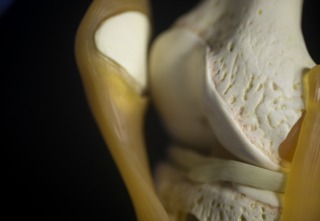 Most health and fitness writers don’t spend a lot of time on cartilage. As tissues go, it’s fairly isolated. It doesn’t contain blood vessels, so we can’t deliver blood-borne nutrients to heal and grow it. Cartilage has no nerve cells, so we can’t “feel” what’s going on. Doctors usually consider it to be functionally inert, a sort of passive lubricant for our joints. If it breaks down, you’re out of luck, they say.
Most health and fitness writers don’t spend a lot of time on cartilage. As tissues go, it’s fairly isolated. It doesn’t contain blood vessels, so we can’t deliver blood-borne nutrients to heal and grow it. Cartilage has no nerve cells, so we can’t “feel” what’s going on. Doctors usually consider it to be functionally inert, a sort of passive lubricant for our joints. If it breaks down, you’re out of luck, they say.
But that’s what people used to think about bone, body fat, and other “structural” tissues: that they are inert rather than metabolically active. The truth is that bone is incredibly plastic, responding to activity and nutrition, and that body fat is an endocrine organ in its own right, secreting hormones and shaping the way our metabolism works. What about cartilage? Can we do anything to improve its strength and function?
Absolutely.
Cartilage is made of water, collagen, and proteoglycans, a protein-polysaccharide bond that provides elasticity. Right there we see one avenue for altering cartilage health—hydration.
Stay hydrated.
Go down to the pet store and look at the dehydrated tendons. They’re dry, stiff, and completely unmanageable. Go down to the Asian market and check out the fresh beef tendons. They’re slippery, pliable, and still tough as nails. Now consider that cartilage and tendon are made of very similar stuff. Without hydration, cartilage doesn’t slide as easily. It can’t do its job.
And once you have cartilage damage, hydration is even more important because damaged cartilage is harder to hydrate. In one study, researchers dehydrated and then rehydrated damaged pig cartilage and intact pig cartilage, finding that the damaged cartilage absorbed far less water than the intact cartilage.
Eat extra collagen/gelatin.
Our need for and collective failure to obtain adequate dietary glycine underpins the growing bone broth/supplemental collagen industry. The reason why drinking broth and eating collagen makes so many people feel better is that we are providing a fundamental nutrient: glycine. See, our bodies need about 10 grams of glycine each day to maintain basic metabolic functions. We only make 3 grams, so 7 grams must come from the diet. A major function of glycine is to maintain and repair cartilage. If you’re training hard or trying to recover from existing damage, your glycine needs skyrocket.
Conclusive studies showing collagen rebuilding or buttressing cartilage are lacking, but we have hints. One study found that supplementary collagen improves joint pain in athletes who complain about their knees. And more recently, a study found that giving dietary collagen alongside Tylenol to patients with osteoarthritis improved joint pain and function over Tylenol alone.
My favorite ways to get collagen include bone broth, adding gelatin to pan sauces, and eating Primal collagen bars.
Move around a lot.
Motion is lotion. You need to walk. You should develop a daily movement practice, even if it’s just bodyweight squats while brushing your teeth and waiting for the train, your favorite VitaMoves routines while watching TV, or a good old fashioned rajio taiso.
Be sure to include mobility work, too, like the aforementioned VitaMoves, KStarr’s MobilityWOD, or MDA writings on joint mobility, foam rolling, and stretching. Many joint injuries occur because the tissues surrounding them—your muscles, your fascia, your major movers—are restricted, placing undo stress on the joint itself.
Walk over varied terrain.
Walking through civilization isn’t the same as ambling across a wild landscape strewn with stones and dips and fallen branches and slippery leaves, inclines and declines and slants. The former is linear and predictable. You just walk without having to think or react. It’s rote.
Walking across varied terrain exposes your cartilage to different positions and different loading patterns.
Go barefoot.
It starts with the foot’s connection to the ground. If you’ve got a big thick slab of rubber blocking the millions of nerves in your feet from sensing the ground, everything up the kinetic chain suffers.
Do so gradually, though. Going barefoot after a lifetime in protective shoes can be a shock. You don’t want to get injured; being sedentary is terrible for cartilage (and everything else).
Travel back in time and quit the soccer team.
If you have kids, don’t force them to specialize. Playing a variety of sports and activities early on and waiting to specialize until later adolescence is better for future athleticism and safer for the joints. Let them be kids. Let them play and cavort and explore multiple sports. Or no sports, just movement, if that’s what they want.
“Chronic repetitive loading” of the joints associated with intense sport practice reliably produces cartilage damage in adults, too. We can’t travel back in time, but we can eliminate any chronic repetitive loading our joints are still subject to.
Join an adult sports league, but don’t get obsessed. Keep doing other stuff, too.
Load.
Osteoblasts are to bone as chondrocytes are to cartilage. Just like an osteoblast responds to load by increasing bone mineral density, chondrocytes respond to load by increasing cartilage growth and repair. You have to load it or lose it. Studies in cows find that cartilage is most robust in joints that actually receive loading.
Research finds that high-load, low-volume back extensions can stimulate healing of damaged intervertebral dics, the pucks of cartilage that line your spinal column.
Use full range of motion on your lifts.
Full range of motion is correct range of motion. It’s what the cartilage is “meant” to handle and respond to. Deep squats, for example, are easier on the joints and make the knee more resilient than half or quarter squats.
Full range of motion is relative, of course. If you can’t squat below parallel without topping forward, don’t force the issue.
Get outside into nature.
Spending time in nature offers many benefits to your cartilage:
You’re more likely to be active, thus subjecting your joints to the loading and multivariate articulations they require to be healthy.
You’ll get more sunlight, which has been linked to better cartilage health in older adults. Curiously, vitamin D supplementation has no effect, so it’s probably the sun.
You’ll lower cortisol and improve your immune response. Elevated cortisol has been shown to impede cartilage repair, and some types of arthritis are autoimmune in nature.
Eat omega-3s and limit excess omega-6s.
Eat wild-caught and fatty fish, like wild salmon or sardines. The omega-3s have been shown to improve arthritis symptoms and even slow degradation of cartilage, and in rats, a balanced omega-3/omega-6 intake inhibits expression of MMP13, a gene involved in the progression of cartilage degeneration.
Don’t worry about nuts or avocados or other whole foods containing omega-6s. Don’t go crazy on them, either. Focus on avoiding high-PUFA seed oils, the densest sources of omega-6 in our diets.
Sleep.
Endogenous growth factors like human growth hormone play major roles in cartilage repair. And absent pharmacological assistance, we get the largest bolus of growth hormone at night, during sleep. Whether we’re recovering from the microdamage caused by smart training and regular loading or the degenerative damage caused by poor mechanics and outright injuries, sleep is where most of the repair happens.
Get your sleep hygiene in order.
Get a slackline.
Read my post from a couple years back on slacklining. I still have the same one set up in my backyard, and I still take frequent breaks to hop on and balance and walk.
Slacklining forces your body to make micro corrections constantly. That’s why a first timer putting foot to slack line will wobble uncontrollably and feel like they don’t know their own body: they’re placing enormous demands on a neuromuscular system that’s never encountered so unstable and dynamic an environment. It takes a while to get their bearings. And all the while, the knees, hips, and ankles are facing very unique loading patterns.
Plus—and this isn’t “scientific” or cited, just personal instinct—anything that puts a smile on your face while it forces a training adaptation will be more effective than one that makes you grimace. Teach your cartilage that work is fun.
Lose excess weight.
There can be too much load. We want the application of loading to be acute and intermittent. We want to control it. So, workouts, hikes, jumping, squatting, climbing, running and other short term activities generally improve cartilage health, particularly when using proper technique and allowing for ample recovery. But carrying 20-30 extra pounds is chronic loading because it never goes away. You can’t take that pack off.
Research shows that weight loss can really improve cartilage health. In one study, obese people with arthritis who lost a large amount of weight (5-10% of their bodyweight) greatly reduced cartilage degeneration. For many of them, it stopped entirely. If weight loss has that big of an effect on existing cartilage damage, imagine how it would affect healthy cartilage.
Those are 13 practices I find most useful in buttressing cartilage against damage and degeneration.
What do you got?
Thanks for reading, all!

The post How to Feed, Train and Care for Your Cartilage appeared first on Mark's Daily Apple.



November 28, 2016
Dear Mark: Hyperthyroidism; Wim Hof and Placebo
 For today’s edition of Dear Mark, I’m answering two questions. The first is a really good one I’m kicking myself for never having considered before: what to do about hyperthyroidism. As the reader notes, everyone’s always talking about hypothyroidism—lack of thyroid function. What about too much thyroid activity? Then, I discuss what Wim Hof means for the placebo effect.
For today’s edition of Dear Mark, I’m answering two questions. The first is a really good one I’m kicking myself for never having considered before: what to do about hyperthyroidism. As the reader notes, everyone’s always talking about hypothyroidism—lack of thyroid function. What about too much thyroid activity? Then, I discuss what Wim Hof means for the placebo effect.
Let’s go:
All the information out there seems to be geared towards hypothyroidism, what about hyperthyroidism? Hard to find anything on treating it with a Primal diet. Lol, maybe I’m just unlucky.
Great question. Hyperthyroidism really does get the short end of the sick, doesn’t it?
What can you do?
There’s apparently an epidemic of hyperthyroidism among cats because I found tons of hyperthyroid cat studies. Luckily, cat hyperthyroidism is similar enough to human hyperthyroidism that we can make some smart inferences.
Reduce iodine: In a recent study, feeding hyperthyroid cats a low-iodine diet reduced thyroid hormones and improved some—but not all—symptoms. Another study had similar results, finding that just 4 weeks on a low-iodine diet were enough to improve fur quality, vomiting, weight loss, and other symptoms.
While I wouldn’t necessarily worry about iodine in common foods like eggs or dairy, don’t go out of your way to increase it. Don’t add seaweed to everything, don’t take iodine drops.
Get adequate selenium: Pregnant women with hyperthyroidism tend to have lower selenium levels than healthy pregnant women, and patients with Graves’ disease (a type of hyperthyroidism) who took selenium alongside their medication saw better results than those only taking medication. However in a later study whose subjects began with adequate selenium levels, extra selenium had no effect.
Reduce BPA and other plasticizers: One of the most consistent associations with cat hyperthyroidism is canned food consumption. Cat food cans are usually lined with BPA or some other plasticizing agent, and these have been shown to disrupt the thyroid. In humans, plastics are associated with lower thyroid levels, while there are different effects in other animals. Either way, it’s likely doing something to your thyroid. I certainly wouldn’t rely on BPA as a thyroid modulator.
Eat crucifers: Broccoli, kale, cabbage, Brussels sprouts, and other cruciferous vegetables contain goitrogens—compounds that inhibit thyroid function. We normally seek to increase thyroid function, but in the case of hyperthyroid a slight depression could help.
Eat your cruciferous vegetables lightly cooked to maximize goitrogenic activity.
Give up gluten: You’re probably already doing this, but be strict. Gluten intolerance and celiac often present with Graves’ disease.
Hope it helps you.
Have you heard about Wim Hof – the Iceman? He harnesses the placebo effect consciously.
Oh, yeah. Wim Hof is an incredible story. From what I can gather, he provides a perfect example of the power of the placebo.
First, if you haven’t heard of Wim Hof, check out this Vice documentary. It’s 30 minutes or so and completely worth watching. Long story short, stricken with grief and the monumental responsibility of caring for his children after the death of his wife, Wim Hof found refuge and new life in nature—by submerging his body in icy rivers. Since then, he’s set 26 world records.
He ran a half marathon in the Arctic circle wearing only a pair of shorts and shoes.
He climbed most of the way up Mt. Everest in shorts and shoes.
He ran a full marathon in the Namib desert without any water.
He swam for almost 60 meters meters under Arctic ice.
More importantly, he trained others to do the same things. In 2014, after just a few days of instruction, 12 of his students were able to successfully counter the inflammatory effect of E. coli endotoxin administration. Both the 12 trainees and a control group were injected with 2 ng of endotoxin, a large enough dose to reliably cause headaches, nausea, and other flu-like symptoms. The trainees blocked the inflammatory response by consciously increasing anti-inflammatory cytokines and neutrophils, experiencing fewer symptoms and normalizing cortisol at an accelerated rate.
Skeptics would look at the clinical validation of Hof’s claims and go, “Well, that’s not the placebo effect. That’s real!” But that’s exactly the point.
The placebo refers to the body’s ability to tap into the subconscious power within. Whether it’s mimicking a painkiller’s analgesia or reducing the dosage of the active drug, the placebo effect is very real, but you don’t control it consciously.
Hof has figured out how to consciously control certain aspects of the autonomous nervous system. He can keep his body temperature within a healthy range and maintain a normal heart rate despite sitting in ice water. He can send blood to tissues on command to keep circulation going. He can bring down the inflammatory response to injected endotoxin, preventing fever and headache and all the other symptoms that normally accompany a healthy dose of e. coli. What I wonder is if Hof and his trainees are actually fighting the infection—sending in immune cells to destroy it—or merely stemming the inflammatory response to it. Time will tell.
I’ve listened to a few podcasts with the guy, and he’s supposed to be embarking on several new avenues of research, including using his methods to fight mental health issues like depression and PTSD. If there’s anything that “placebo” can help, it’s those conditions.
To sum up, I like Wim Hof a lot, and I think he’s a remarkable example of the placebo effect’s potential.
That’s it for today, folks. What about you? What’s your take on hyperthyroidism and Primal? Have you looked into Wim Hof’s exploits?
Thanks for reading!

The post Dear Mark: Hyperthyroidism; Wim Hof and Placebo appeared first on Mark's Daily Apple.



November 27, 2016
Weekend Link Love – Edition 428
 Research of the Week
Research of the WeekCompared to Bronze Age Europeans and contemporary Northern Europeans, Southern Europeans tend to be better at converting short chain PUFAs (linoleic acid and ALA) into long chain PUFAs (arachidonic acid, EPA, DHA).
The results of many clinical trials are never published. Why’s that?
Teens are better at math in the mornings (PDF).
Vitamin D protects worms against aging and Alzheimer’s.
New Primal Blueprint Podcasts
Episode 144: Matt and Keris Whitmore: Host Brad Kearns chats with UK-based Matt and Keris about the link between your skin and your overall health, how training in hot weather affects your gut, what keto means for your training, the release of their new book Paleo Primer: A Second Helping, and much more.
Each week, select Mark’s Daily Apple blog posts are prepared as Primal Blueprint Podcasts. Need to catch up on reading, but don’t have the time? Prefer to listen to articles while on the go? Check out the new blog post podcasts below, and subscribe to the Primal Blueprint Podcast here so you never miss an episode.
5 Common Prescriptions That Should Require Nutritional Counseling
Interesting Blog Posts
As with seemingly everything, autophagy has a dark side.
Media, Schmedia
Millennials are spending so much time sitting in front of screens that they’re getting varicose veins, hemorrhoids, bad backs, and bum knees. Next up: AARP memberships.
Meanwhile, dementia rates are dropping even as the population ages.
Everything Else
When it comes to studying the relationship between saturated fats (or any single nutrient) and heart disease, context matters.
You know our soda intake is excessive when you use “bathtubs” as a unit of measurement.
Rwandan gorillas are conducting uncharacteristic acts of mob violence.
Every Thanksgiving, backyard football injuries skyrocket.
Where’s a hyphen when you need one?
Things I’m Up to and Interested In
Editorial every MD should read: “More clarity needed on the true benefits and risks of statins.”
Product that keeps ending up in my mouth: Our new Primal Kitchen Chocolate Hazelnut Bar, which is like a better, chewier version of Nutella that doesn’t leave you weeping with regret at 3 AM in a pile of empty jars.
Articles I’m flabbergasted had to be written: “Let’s face it, keeping children sedentary for most of their waking hours is causing harm.”
News I enjoyed: People are Googling the hell out of turmeric, kefir, and other functional foods.
News I did not enjoy: 85% of food in the U.S. contains pesticide residues (PDF).
Recipe Corner
While some of the ingredients are iffy (peanut butter powder and rice flour), this black sesame gelato is absolutely gorgeous.
This chicken paillard with onion-pepita relish will leave you well fed.
Time Capsule
One year ago (Nov 27 – Dec 3)
4 Ways Winter Affects Your Physical Health – How our bodies respond to the seasons.
8 Common Cold Cures That Actually Seem to Work – Try some of these to fix your sniffles.
Comment of the Week
“The technical revolution of food is so 1850.”
Joselyn Hoffman Schutz – in response to the “Can Techies Improve Food?” Facebook posting

The post Weekend Link Love – Edition 428 appeared first on Mark's Daily Apple.



November 26, 2016
Cassava Flour Crepes
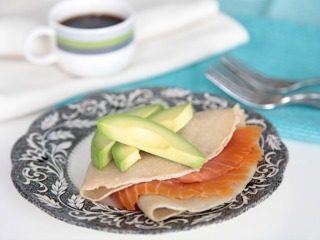 These are the real deal—crepes that are almost identical to regular crepes, with one simple difference: they’re made from gluten-free cassava flour. Stuff these buttery crepes with either sweet or savory fillings, and they’re a delicious treat for breakfast or brunch.
These are the real deal—crepes that are almost identical to regular crepes, with one simple difference: they’re made from gluten-free cassava flour. Stuff these buttery crepes with either sweet or savory fillings, and they’re a delicious treat for breakfast or brunch.
The great thing about cassava flour is that it’s a whole food that can be used to make gluten-free, grain-free, nut-free baked goods. Although cassava flour isn’t a perfect replacement for all-purpose flour, it’s pretty darn close. It’s fun to experiment in the kitchen with cassava flour, but also expensive. A 2-pound bag can set you back around $20.
In this recipe, the experimentation has been done for you, guaranteeing reliably delicious crepes. Before substituting cassava flour for all-purpose flour in other recipes, keep three things in mind:
One: Cassava does not give baked goods a grainy or chewy texture like nut flours, coconut flour or tapioca flour might. However, it does have a heavier texture than all-purpose flour. This makes it harder to achieve light and airy baked goods. It also means that cassava flour isn’t always the best flour for cakes, loaves of bread, or anything you want to rise up. In these cases, blending cassava flour with another type of flour works better.
Two: Cassava flour imparts a slight flavor. It’s pleasant though—a nutty, earthy flavor that’s easy to get use to.
Three: Cassava flour soaks up more liquid than regular flour. If you’re substituting cassava flour for all-purpose flour, plan to add more liquid than usual, or use the same amount of liquid that your recipe calls for and slightly less cassava flour.
Cassava flour is made from the whole cassava (yuca) root, after it’s peeled, dried, and ground. This makes it different from tapioca flour, which is starch that’s extracted from the cassava root. Although cassava flour has a place in a Primal kitchen and can lead to better tasting baked goods, it’s not a miracle food. It’s still just flour. High in carbs and low in fiber and nutrients, it’s not an ingredient for every day.
What you can do, however, is stuff your cassava crepes with ingredients that are nutrient dense, balancing out what’s lacking in cassava flour. Fresh berries, salmon and avocado, scrambled eggs, roasted vegetables and shredded or ground meat are all delicious options.
Servings: 6 crepes
Time in the Kitchen: 25 minutes
Ingredients

1 cup cassava flour (130 g)
½ teaspoon kosher salt (2.5 ml)
2 eggs, whisked
1 ½ cups water, (350 ml) or 1 cup water and ½ cup milk (dairy, coconut or nut milk)*
2 tablespoons melted unsalted butter (30 g)
½ teaspoon vanilla extract (optional—best with sweet crepes) (2.5 ml)
*Crepes made with only water, instead of milk and water, are slightly lighter in both texture and flavor
Instructions
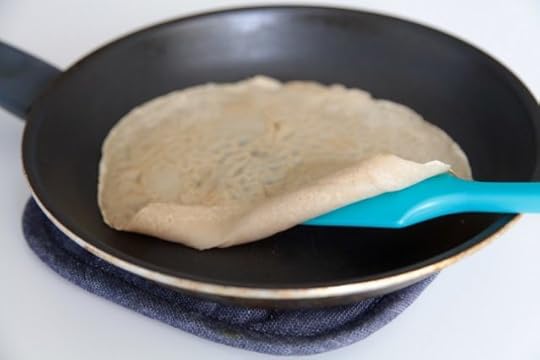
In a medium bowl, whisk together cassava flour and salt.
In a second bowl, whisk together eggs, water (or water and milk), butter and vanilla.
Very slowly pour the wet ingredients into the dry, mixing gently until the flour has absorbed all the liquid. The batter should have a texture that is similar to pancake batter.
Heat an 8-inch non-stick skillet with a small pat of butter over medium heat. When the butter melts, pour 1/3 cup batter in the pan, swirling the pan as you pour, so the batter covers the entire pan. Work fast, as the batter cooks very quickly.
Cook the crepe 2 minutes, then use a rubber spatula or pancake turner to lift the edge and flip the crepe over. Cook 1 to 2 minutes more, then lift the crepe from the pan. Fill the crepe with your desired filling, then fold or roll up and enjoy. The crepes are good both warm and at room temperature.


The post Cassava Flour Crepes appeared first on Mark's Daily Apple.



November 25, 2016
I Have Never Felt Healthier and Happier in My Life
It’s Friday, everyone! And that means another Primal Blueprint Real Life Story from a Mark’s Daily Apple reader. If you have your own success story and would like to share it with me and the Mark’s Daily Apple community please contact me here. In fact, I have a contest going right now. So if you have a story to share, no matter how big or how small, you’ll be in the running to win a big prize. Read more here.

I’ll start off with the disclaimer that my story is only in its early chapters, but it has already been life changing nonetheless.
In November of 2015, at the age of 23, after many years of excruciating pelvic pain, fatigue, chronic inflammation, and GI issues, I underwent an exploratory surgery and was diagnosed with a chronic illness called Endometriosis. Once a face was finally put to the culprit behind the past 8 years of my suffering, I decided that I would no longer let it control my life.
In January of this year, after discovering (through hours of research) and reading The Primal Blueprint, I knew it was time to honor my body in every way I could. The moment I finished the book, I vowed that I would forever put my health at the top of my priority list. So on that day, I broke the insulin-producing, inflammation-promoting, addictive diet that I had ignorantly been poisoning myself with my entire life.
 The first few days were difficult. I was irritable, I had headaches, I wasn’t satiated regardless of how much I ate. After the brutality of what I now know was withdraws (as I would consume grains with virtually every meal, and indulge in dessert or candy multiple times a week), I was on the up.
The first few days were difficult. I was irritable, I had headaches, I wasn’t satiated regardless of how much I ate. After the brutality of what I now know was withdraws (as I would consume grains with virtually every meal, and indulge in dessert or candy multiple times a week), I was on the up.
Within two months, I inadvertently lost about 12 pounds of fat. My daily stomach upsets had almost diminished, and most importantly my chronic pain became less and less frequent. My mood had stabilized, my sleep had deepened, and my energy had increased significantly.
It’s truly been a miracle. I couldn’t remember the last time that I could go through a whole day without a terribly upset stomach or excruciating pains. And now those aches and pains are few and far between. I have never felt healthier and happier in my life. All that I can think is that the world needs to know this! There is basically a miracle pill out there that can make you healthier, happier, stronger, and live longer!
In fact, I am so in awe of the miracle that is the Primal lifestyle that I have taken the step towards sharing this invaluable knowledge with the world. I began the Primal Health Coaching program a couple of months ago, and I couldn’t be more thrilled to bring to others what The Primal Blueprint has done for me.
 There are so many people out there suffering from chronic pain and inflammation that rely on daily medications to get even an ounce of relief. They feel confused, angry, hopeless, and weak. I know because I was once that person. Thanks to the Primal Blueprint, instead of allowing my diagnosis to mark my life with woe, I have used it to propel me out of the darkness and into the light—towards chronic health and away from chronic illness.
There are so many people out there suffering from chronic pain and inflammation that rely on daily medications to get even an ounce of relief. They feel confused, angry, hopeless, and weak. I know because I was once that person. Thanks to the Primal Blueprint, instead of allowing my diagnosis to mark my life with woe, I have used it to propel me out of the darkness and into the light—towards chronic health and away from chronic illness.
So from the bottom of my heart, thank you Mark and all of you at Primal Blueprint, Primal Kitchen, and Primal Health Coaching for changing my life and providing the information and support to sustain the healthiest lifestyle possible. I look forward to continuing to learn as much as I can and sharing this wealth of knowledge with all that I can.
The post I Have Never Felt Healthier and Happier in My Life appeared first on Mark's Daily Apple.



November 24, 2016
Happy Thanksgiving
 I’ve always considered Thanksgiving the most Primal of the holidays. There’s little fanfare beyond the company and food. The act of preparing and sharing a feast is about as basic, but intimately sacred, as human ceremony gets. Add to this the focus on gratitude itself, the turning of our attention toward all that is good or has brought good to our lives. What comes to mind for me is communal offering and celebration around the table much like Grok’s kin around the fire.
I’ve always considered Thanksgiving the most Primal of the holidays. There’s little fanfare beyond the company and food. The act of preparing and sharing a feast is about as basic, but intimately sacred, as human ceremony gets. Add to this the focus on gratitude itself, the turning of our attention toward all that is good or has brought good to our lives. What comes to mind for me is communal offering and celebration around the table much like Grok’s kin around the fire.
Thanksgiving also, along with New Year’s, counts as one of the primary times set aside for reflection. To consider what we’re grateful for, we take stock of the year and its blessings as well as its struggles. Often, we may be most thankful for the resilience and support that got us through the challenges. We rest in the comfort of ritual and cycle, participating in the arc of the collective, ancestral human story.
Each year I say it, and each year I’m filled with the truth of it: I look to this community with heartfelt gratitude. The journey that began a decade ago with the creation of Mark’s Daily Apple has become more than I’d ever hoped. It’s grown into an expansive exchange of ideas and encouragement. It’s been a substantive part of the health conversation in our culture, and it’s developed into a personal mission far grander than anything I’d imagined.
So, thank you. Thank you for reading, for sharing, for contributing. Thank you for carrying the message of health and for supporting each other here.
I’ll have some big announcements in the New Year and even as we close out 2016. As always, stay tuned. For today, however, I hope this day finds you well and savoring the occasion in whatever way fits your pleasure.
Best to everyone here, whether you’re celebrating today or not.
To reflecting on the day and to making the most of this full holiday weekend, I offer a few of our best articles from the Thanksgiving archive. Enjoy, and Grok on!
5 Responses When Relatives Ask Why You’re Not Eating Stuffing This Thanksgiving
What It Means to Be Thankful for Your Health
And for after the holiday…because how could we leave out the leftovers?
How to Make Turkey Jerky (That’s Super Easy and Tastes Like Thanksgiving)
Thanks for stopping by today. Happy Thanksgiving to you and yours!

The post Happy Thanksgiving appeared first on Mark's Daily Apple.



November 23, 2016
Should You Rethink Your Meal Timing for Weight Loss?
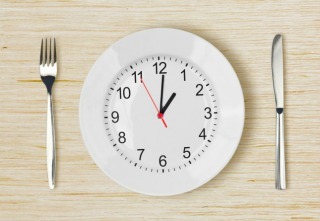 I’ve written about what to eat. I’ve written about what not to eat. I’ve even discussed the benefits of occasionally eating things you “shouldn’t eat.” I’ve written about skipping breakfast, eating a big lunch, and skipping entire days of meals altogether. I’ve discussed sleeping low (carb) and punctuating a low-carb diet with occasional high-carb refeeds. But I haven’t written very much about when to eat.
I’ve written about what to eat. I’ve written about what not to eat. I’ve even discussed the benefits of occasionally eating things you “shouldn’t eat.” I’ve written about skipping breakfast, eating a big lunch, and skipping entire days of meals altogether. I’ve discussed sleeping low (carb) and punctuating a low-carb diet with occasional high-carb refeeds. But I haven’t written very much about when to eat.
I won’t tell you when to eat. There are many paths. You must find the one that takes you to your goal. But there are some physiological “truths” that impact how we process food depending on what’s happening in our lives which seem to apply to all humans. I’ll discuss several ways to think about meal timing, and then you can decide which concepts make sense for you and your life.
Eating shortly before or after a workout will improve the metabolic response to the meal.
Conventional Primal wisdom says that you can’t out-exercise a bad diet. Is it true?
Kinda. Nothing, except god-tier genetics, will protect you against a diet of exclusively deep-fried food. Even if you were to maintain good body comp, I’d hate to see how you looked on the inside.
But that doesn’t erase the fact that training alters the metabolic effects of a meal and the fate of the nutrients comprising it.
Research has found that a bout of full-body resistance training done prior to a meal offers more protection against postprandial lipemia than a bout of aerobic training, despite the former burning fewer calories than the latter.
Resistance training also sensitizes skeletal muscle to insulin (so you need less insulin to do the same job and can burn more fat as a result) and increases glycogen storage (so glucose fills muscle glycogen stores rather than contributes to energy overload and eventual fat gain). It increases muscle protein synthesis, creating an “anabolic window” for dietary protein to contribute to muscle gain.
Anything works, though. Moderate to high intensity aerobic activity creates a glycogen debt that must be filled, so the body oxidizes fat to allow glucose entry into glycogen stores. Low intensity aerobic activity doesn’t create a glycogen debt but does burn fat (and trains your body to burn fat more efficiently).
In my experience, full body resistance training using compound movements creates a “black hole” effect. I get incredibly hungry, and no matter what I eat, nothing changes. I even find that after a lifting session, eating more carbs, sugar, and even wheat or alcohol have very few negative effects, almost like lifting makes me more resilient over all.
Don’t become wedded to your workouts, though. Don’t fear eating outside of a post- or pre-workout window. The anabolic window opened through exercise lasts for hours, not minutes. Many studies show that exercising today improves the postprandial metabolic response tomorrow. But any type of activity, even just a walk, before or after a meal can really improve how you respond to it.
Eating right before bed truncates the sleep-induced fasting state.
Everyone reading this blog for more than a few months has picked up on the notion that fasting from time to time is beneficial. Whether it’s skipping a meal or three, going without food for a little while upregulates autophagy, increases fat burning, and exerts potentially anti-aging effects.
Sleep is a freebie for the fasting—curious. It’s built in. You have dinner in the early evening and hang out for a few hours. You brush your teeth, take a bath, and relax before bed. Once you’re in bed, you read a good book or engage in something slightly more physical and enjoyable before you actually fall asleep. And then you sleep. Growth hormone spikes, fat burning skyrockets, cellular repair occurs, brain pruning engages. You wake up and, at some point, eat. That’s at least 8-12 hours (and probably more) of quality fasting time—without even trying.
If you eat dinner late at night, you lose valuable fasting time.
One recent study even found that skipping dinner or having it in the early evening reduces hunger, increases fat burning, and improves metabolic flexibility (the ability to switch between fat and sugar burning). They didn’t follow the subjects long enough to detect weight loss, but a similar setup led to increased fat loss in rats.
However, if you’re a nighttime snacker, meaning you wake up in the middle of the night hungry and end up eating, pushing dinner back before bed or having a snack after dinner can help you avoid it.
If you do eat dinner later, push breakfast back a bit. What we’re ultimately after is that 10-12 hour block of not eating anything. I’ve already laid out exactly why skipping or delaying breakfast is not only safe for most people, it’s downright beneficial and often promotes weight loss.
Eating with the light may provide a boost to health.
There isn’t just one central clock running things. There are hundreds of biological clocks associated with nearly every tissue, muscle, and organ—the “majority of the cells in the body“—and they all respond to circadian entrainment stimuli. Foremost among the entrainers is light. At the right times (day), bright light gets the clocks moving.
Eating is another powerful entrainer of the circadian rhythm, with larger meals having the biggest entrainment effects. Insulin sensitivity follows a circadian rhythm, and it’s different for muscle and adipose tissue. Muscle insulin sensitivity is high in the morning and declines as the day progresses. Adipose tissue insulin sensitivity is lowest in the morning and increases as the day progresses. This is most pronounced in women, by the way.
This is why you have something called “afternoon diabetes,” where insulin sensitivity has degraded to the point of glucose intolerance by lunchtime. It’s why eating at regular times improves insulin sensitivity and lipid profiles—your mealtimes are attuned to the biological clocks determining your metabolism.
Bill Lagakos has written extensively about the utility of eating with your circadian rhythm and boils it down to this:
Eat with the sunrise, focusing on protein and carbs (to take advantage of high insulin sensitivity and pair two major circadian entrainers—light and a large meal).
Eat progressively smaller meals throughout the day. Breakfast like a king, lunch like a prince, dinner like a pauper (or not at all; if you want to skip a meal, skip dinner).
More protein and carbs in the earlier part of the day, more fat and low-carb veggies at night to take advantage of the diurnal variation in adipose tissue/muscle insulin sensitivity.
I’m pretty lucky. As an insulin-sensitive dude to begin with, I can get away with any type of eating schedule. Always have, probably always will. If that wasn’t the case and I had problems with insulin resistance, I’d probably try something close to what Bill discusses.
Find a schedule and stick to it.
Once you figure out what seems to work, stick with it. Skip meals if you like, but try to eat at roughly the same time each day. This conditions your body to expect food (and get hungry at the right time, not before), and it improves the metabolic response to eating.
In a recent study, the authors actually tested the effect of breaking your eating habits by separating overweight women into habitual breakfast skippers and habitual breakfast eaters and then having them either skip breakfast or eat breakfast.
Habitual breakfast eaters who skipped breakfast experienced way more hunger at lunch, had worse blood lipids, and higher insulin levels. They had worse blood lipids and their insulin skyrocketed. Habitual breakfast skippers who skipped breakfast experienced none of these deleterious effects.
Meanwhile, habitual breakfast eaters who ate breakfast were more satiated at lunch. They had better blood lipids and normal insulin levels. Habitual breakfast skippers who ate breakfast were still hungry at lunch. Eating breakfast didn’t inhibit their regular lunch-time appetites.
Other research has found that maintaining a regular eating schedule improves insulin sensitivity, increases energy expenditure, and improves fasting lipids. Overall, sticking to an (rough, not draconian) eating schedule results in the best metabolic effects.
What’s it all mean?
Whatever you want.
Humans are flexible beings by nature. We adapt. We roll with the punches. We thrive on a wide variety of foods and eating schedules, even if we seem to do best on a consistent schedule—whatever that may be.
As always, my message is one of freedom. You make the choice when to eat. You decide. I provide some of the information you might not have considered, and you do whatever you want with it.
What do you think, folks? Do you worry about meal timing, or do you just go with the flow? Noticed any differences?
Thanks for reading, all. Take care!
The post Should You Rethink Your Meal Timing for Weight Loss? appeared first on Mark's Daily Apple.



Mark Sisson's Blog
- Mark Sisson's profile
- 199 followers




